 Delicious Salmon and Salad Dinner loaded with good fat and fibrous veggies Delicious Salmon and Salad Dinner loaded with good fat and fibrous veggies * Remember to always consult with your physician in regards to starting or changing your diet and in no means is this information meant to diagnose or treat any condition. For full legal disclaimer, see About Me page. Now that I have been following a Ketogenic diet for a little over two years, I thought it would be a good time to do an update on what I've learned, where I'm at and what I have found to work and not work for me. (Read This To See How I Got Started With Ketogenic Diet.) What is The Ketogenic Diet? "The ketogenic diet was designed in 1924 by Dr. Russell Wilder at the Mayo Clinic. Despite being highly effective in treating epilepsy, it fell out of fashion due to the surge in new anti-seizure medications in the 1940s.” www.CharlieFoundation.org Through research, it was found that when kids with drug resistant epilepsy fasted, they no longer had seizures. Since they could't fast these kids or any human for that matter indefinitely, they began to develop a diet that mimics fasting physiologically, in order to provide the kids a way to avoid seizures, but still give their bodies the nutrients they need to survive. This was the ketogenic diet which is defined as a diet with the macronutrient ratio of 70-75% fat, 20-25% protein, 5-10% carbohydrates. -ketogenic-diet-resource.com (These ratios can shift slightly depending on your particular body type, activity level and history.) The diet gets its name from the fact that when you switch to a high fat, moderate protein and low carb diet, your body begins to shift its main energy source away from glucose to ketone bodies, which come from fat and fat metabolism. When you are using these ketone bodies as your primary fuel source, you are said to be in ketosis, which can be tested a few different ways.  Dessert : Homemade Plain Yogurt Topped with Raspberries and Macadamia Nuts Dessert : Homemade Plain Yogurt Topped with Raspberries and Macadamia Nuts What I’ve Learned The Bad No One-Size-Fits-All As with any diet there is no one size fits all protocol. For some people, eating Paleo is the perfect way to eat and for others, eating a vegetarian diet can be best for them. Even with the Ketogenic diet, it takes trial and error to figure out what your specific carbohydrate and protein intake levels should be. This varies person to person. Timing The timing in when you choose to eat your meals didn’t seem like it would be that significant of an issue but after some experimentation I stand corrected. I have found over this past year that timing of your meals is very important, if not just as important as what you are eating. I came across some interesting approaches to eating that are more focused on the timing of your nutrition rather than simply what you are eating. Eating on a schedule that’s consistent with your sleep-wake cycle or circadian rhythm rather than just eating whenever you feel like it was a main focus. This does seem to have a lot of logic as well as some interesting scientific theory to support this. According to this approach, for me the ideal time to eat would be in the mornings shortly after waking up and during the daytime, and avoiding food in the evening and through the night. My current eating schedule is almost the mirror image of this, having all of my food consumption in the daytime and evening and avoiding food in mornings. I tried to make the switch and failed miserably. After only a few weeks, I finally threw in the towel and decided that for me, the routine of eating in the evening was more important than trying to optimize my “eating time schedule”.  Brunch : Eggs Topped with Avocado, Salad and a Meat Bar Brunch : Eggs Topped with Avocado, Salad and a Meat Bar Not All Fats Are Created Equal For many of you, this is nothing new and can even make some intuitive sense. The fat you consume from french fries for example, which has been cooked at a really high heat, then reheated many times and is often cooked in poor quality (pro-inflammatory) cooking oil will not provide the same nutrient benefits as the fat from an avocado would. This is actually more important than I ever would’ve thought. The importance of not only getting enough fat but also getting good quality fat and avoiding too much poor quality and damage fats and worst of all, poor fats that are than damaged. Fiber Fiber Fiber One of the biggest mistakes I have found with my own implementation of this ketogenic diet is not getting enough fiber. Now that I have learned different tools and foods to utilize this is no longer an issue for me. I do think this is unfortunately under emphasized when the ketogenic diet as discussed when in fact it is very important to include high fiber foods into this diet. This fiber is also going to help your gut microbiome which is the ultimate driver of how your body utilizes nutrition. Dairy Sparingly For myself, I have to be cautious and sparing when using dairy. I don’t tend to tolerate milk but seem to do ok with homemade yogurt, small amounts of whipped cream as well as butter and ghee. Other sources of fat that I do well with include; avocados, macadamia nuts, coconut oil, avocado oil, green olives, some cheese, cocoa butter and butter as previously mentioned as well as eggs and other animal fats. 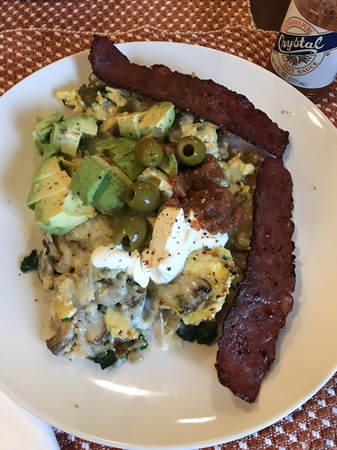 Brunch : Veggie and Egg Scramble Topped with Green Olives, Avocado, Sour Cream, Salsa and Hot Sauce Brunch : Veggie and Egg Scramble Topped with Green Olives, Avocado, Sour Cream, Salsa and Hot Sauce The Good This way of eating and focusing my nutrition continues to be beneficial. I have seen this in many respects in my own life as well as with my fiancé and others that I’ve seen undertake this way of eating. Reduced Number Of Meals Needed Eating nutrient dense food as well as adapting to using fat for fuel allows me to eat less meals, usually 2 per day, which makes life easier. Saved Time Reduced time spent dealing with food and or cooking is a huge bonus that I really enjoy, especially on those really busy days when I can choose to skip a meal without problems like loss of energy or focus. Reduced Body Fat I am able to maintain low body fat while keeping high energy and not having to worry about fat gain. My body fat percentage continues to remain low at 7.7% keeping me in the healthy range for this measure. Continued Muscle Gain I am able to make continued progress with conditioning as well as strength and muscle gain. My energy stays up for intense weightlifting and High Intensity Interval Training. Also, I gained 5.4 lbs of lean muscle over this past year. Improved Stomach and Digestive System This has been one of my biggest challenges throughout my life of always dealing with indigestion and a overall sensitive digestive system. I have much more control and consistency with my digestion especially after increasing my fiber intake and fermented foods such as sauerkraut. 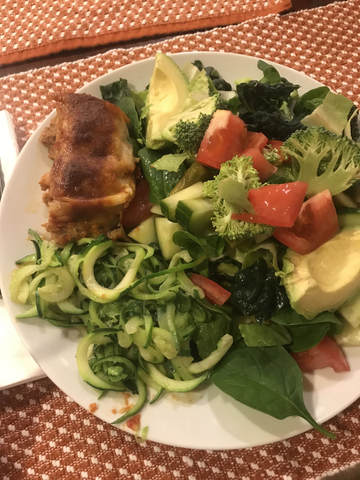 Dinner : Homemade Meatloaf with Grass Fed Beef, Spiralized Zucchini, and Salad with Avocado Dinner : Homemade Meatloaf with Grass Fed Beef, Spiralized Zucchini, and Salad with Avocado The Modifiers Restaurants A few things I should mention as the way that I approach my nutrition could very well be different than many others. Based on my current lifestyle, schedule and daily obligations, I rarely ever eat out at restaurants and therefore have almost 100% control of the food that I eat. This is mostly because of the quality of food is better and I get to choose all the ingredients that I have in my meals including the cooking oils and temperatures my food is being heated to. Many substitutions could be made at restaurants, though this is not something that I do myself often. Intermittent Fasting This is been one of the key components for me as part of this way of eating and nutrition. Having the ability to not eat breakfast most days as well as sometimes skip lunch on days that I need to for scheduling reasons or simply to give my digestive system more of a break. This has added significant value to this way of eating for me. Conclusion My Current Status/Perspective Starting 2 years ago, I have continued to eat this high fat, moderate protein, low carbohydrate diet and in the past year I have gained 6 pounds, 5 of which are lean muscle and 1 pound of body fat according to hydrostatic body weight measurement. I also experienced 2 unfortunate injuries over this past year which did complicate and cause me to miss strength training and conditioning for a few months. But despite this, I have continued to make progress with my overall strength and conditioning and believe that’s because of my diet and nutrition. I continue to see value in this way of eating and encourage anyone with an interest in improving their health to, at minimum, educate themselves to the different ways of getting your nutrition. Then to try and do research to figure out which may be the best for you. Again, this diet is in no way shape or form the best or only diet for everybody. In fact, it is worth repeating that I don’t believe there is one diet for everybody. Instead, there are principles and insights that we can understand and learn and try to implement in our own approach to eating. Follow this up with self experimentation and trial and error. If something is not working for you, then look further for other options or ways to approach this issue. Whether you’re trying to gain muscle, lose fat, reduce inflammation, or whatever your goal is, there are different ways of eating that can help support you and finding which one fits you best is key.
4 Comments
As humans we are one of the most amazing and adaptive species on the planet. We adapt so well that this adaptation can sometimes have negative consequences, for example, adaptive poor posture, rounded shoulders, hunched spine etc. But, this adaptation can also happen in the opposite direction where we can make physical improvements over time by practicing good positions and adapting to productive stresses on the body. One of the most common elements that I see and have dealt with myself is shoulder injuries. This can vary far and wide in how symptoms manifest, but are often-times a result of a few common problems. These can often be improved with a few basic exercises. Over the years I have dealt with many of my own shoulder injuries including a rotator cuff and labrum repair about 15 years ago. Ever since then, I have had to put in extra time and focus on my shoulder to continue to allow for proper function mechanics. This includes mobility, stability and more but all starts with my go to shoulder warm up. I complete this before participating in any exercise or challenging life tasks. * Remember to always consult with your physician or physical therapist in regards to starting or changing your exercise routine and in no means is this information meant to diagnose or treat your injury. For full legal disclaimer, see About Me page. First start with good posture. (Click here to find out what good posture means if you are not sure.) With all the exercises that I will be sharing this is how to start the movement from this optimal posture position. 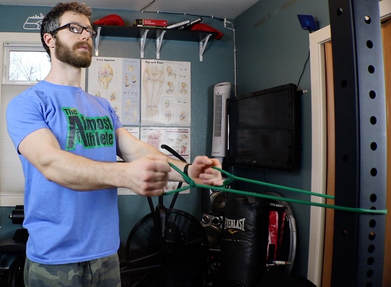 Standing Rows Starting Position Standing Rows Starting Position #1) Standing Rows Purpose This is a great exercise to help promote postural awareness as well as warm up your muscles including your rhomboids, middle traps, lower traps, deltoids, biceps and others.  Standing Rows Mid Point Position Standing Rows Mid Point Position How To Start by standing up tall with good posture. Wrap your resistance band around a post or or securing it in a door. Pull the band back with your arms by your side between your hips and your armpit by squeezing your shoulder blades together then slowly release your arms forward until your elbows are straight. Repeat this 10 times 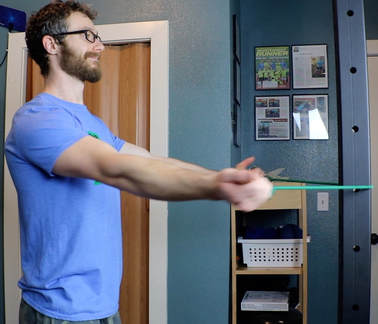 Shoulder Extensions Starting Position Shoulder Extensions Starting Position #2) Shoulder Extensions Purpose This exercise is important for continuing to warm up the muscles that surround the shoulder joint as well as to practice some mobility within the shoulder joint in a plane of motion that we often times neglect to utilize. When this becomes limited, this can lead to many shoulder problems including problems with the bicep tendon and rotator cuff muscles to name a few. 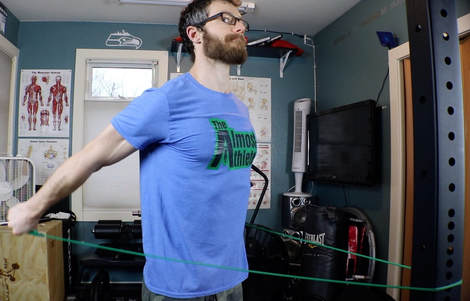 Shoulder Extensions Mid Point Position Shoulder Extensions Mid Point Position How To Again starting with good posture and the same resistance band. Straighten your arms so your elbows are extended and your hands are by your sides. Now pull your shoulder blades together and bring your arms behind you as far as you comfortably can, while trying to keep your shoulders down and back. Once you cannot go any further, slowly return of your starting position while maintaining the shoulder blade squeezed together as well as good posture throughout. Repeat this 10 times 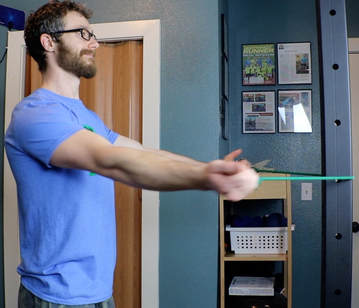 Standing T's (Horizontal Abduction) Starting Position Standing T's (Horizontal Abduction) Starting Position #3) Standing T’s (Shoulder Horizontal Abduction) Purpose Standing T’s help to activate and increase awareness of your shoulder stabilizers including your rotator cuff as well as your postural support muscles. Muscles being used include; infraspinatus, teres minor, mid traps, rhomboids, lower traps, posterior deltoid and others. This can also help to undo some of the excessive forward postures that we tend to adapt to during the work day. And finally, this can provide improved kinesthetic awareness of where your body is at in time and space which helps with posture.  Standing T's (Horizontal Abduction) Mid Point Position Standing T's (Horizontal Abduction) Mid Point Position How To Start by finding your good posture position with your core engaged. Next, raise both of your arms out in front of you with your elbows straight, then bring both arms out to your sides then back behind you, focusing on pinching your shoulder blades together to make this movement happen. Now, bring your arms out in front of you again. Repeat this 10 times.  Standing Y's (Shoulder Flexion) Starting Position Standing Y's (Shoulder Flexion) Starting Position #4) Standing Y’s (Shoulder Flexion) Purpose Standing Y’s help to activate and increase awareness of your shoulder stabilizers including your rotator cuff as well as your postural support muscles. Muscles being used include; infraspinatus, teres minor, mid traps, rhomboids, lower traps, posterior deltoid and others. This can also help to undo some of the excessive forward postures that we tend to adapt to during the work day. And finally, this can provide improved kinesthetic awareness of where your body is at in time and space which helps with posture. 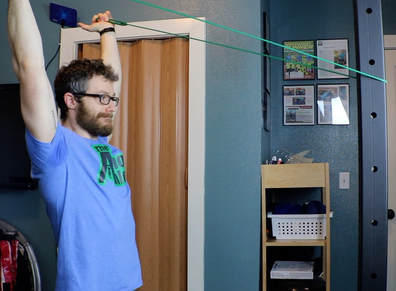 Standing Y's (Shoulder Flexion) Mid Point Position Standing Y's (Shoulder Flexion) Mid Point Position How To Start by finding your good posture position with your core engaged. Next, raise both of your arms out in front of you with your elbows straight and thumbs up, then bring both arms up towards your head, trying to get your arms just outside of your ears, focusing on bring your shoulder blades together and down to make this movement happen. Now, bring your arms back down in front of you again. This should look similar to the “touchdown” sign the referee's signal in football. Repeat this 10 times.  Shoulder External Rotation Starting Position Shoulder External Rotation Starting Position #5) Shoulder External Rotation Purpose This exercise specifically works on warming up your shoulders, deltoids and the rotator cuff muscles as well as continued postural awareness.  Shoulder External Rotation Mid Point Position Shoulder External Rotation Mid Point Position How To Starting with good posture. Again you’re going to grab the band in front of you with your left hand holding about halfway down the resistance band. With your right hand on one of the handles and maintaining good posture. With your elbow close to your side, you’re going to rotate your arm and externally (towards your right, away from your body). Once you have rotated us as far as you can comfortably without compromising your good posture, then slowly bring it back to your starting position. Repeat this 10 times. *Note some people have excessive shoulder range of motion and can rotate much further than necessary. If this is you, only rotate to about 45 to 75° and focus on maintaining good positioning.  Shoulder Blade Push Ups Stating Position Shoulder Blade Push Ups Stating Position #6) Shoulder blade push-ups at a desk or wall Purpose Shoulder Blade Push-Ups help to activate and increase awareness of your shoulder and scapular stabilizing muscles including your serratus anterior. These muscles tend to become under-developed and often times shut down on many of us and this problem becomes worse with poor posture. These muscles help to keep your shoulder blade in the proper position and assist with shoulder movements especially when lifting or reaching with our arms. Finally, this can provide improved kinesthetic awareness of where your body is at in time and space which helps with posture.  Shoulder Blade Push Ups Mid Way Position Shoulder Blade Push Ups Mid Way Position How To Start by finding your good posture position with your core engaged. Next, finding a clear spot on a wall or desk, and place your hands there about your shoulder width apart and just below shoulder height. Now, keep your elbows straight, pinch your shoulder blades together to bring your body slightly closer to the wall, then, spread your shoulder blades apart to push your body slightly farther away from the wall. You should be focusing on pinching your shoulder blades together then spreading them apart to make this movement happen. Remember this is a small movement where you don’t want to bend your elbows or round your back at all throughout this movement. Repeat this 10 times. Conclusion Although shoulder injuries, aches and pains are all too common, many can be improved or mitigated with some simple and consistent effort towards improving postural awareness as well as joint stability and mobility. And, although this is not a exhaustive list of all important shoulder exercises, this warm-up series has been a big help for me to maintain and improve with function of my shoulders. |
Author : Jordan ProudfootHere are my thoughts and insights into fitness and wellness to be the best you possible. Archives
February 2019
Categories
All
|


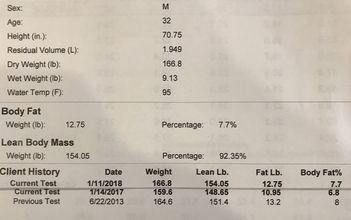
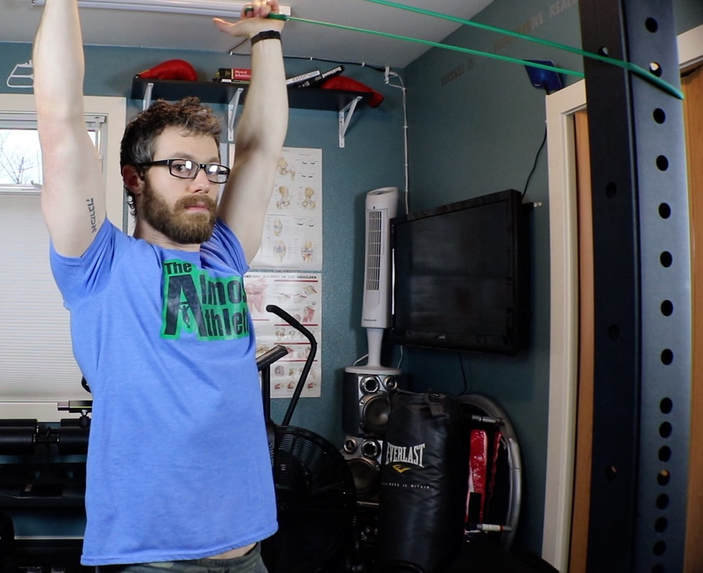
 RSS Feed
RSS Feed
